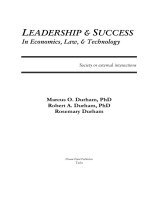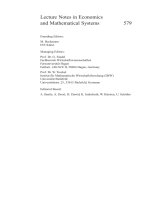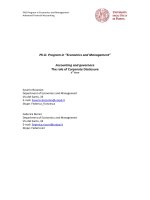Educational innovation in economics and business pedagogy, technology and innovation
Bạn đang xem bản rút gọn của tài liệu. Xem và tải ngay bản đầy đủ của tài liệu tại đây (3.28 MB, 406 trang )
Educational Innovation in Economics and Business VIII
Educational Innovation in Economics and Business
Volume 8
The titles published in this series are listed at the end of this volume.
Educational Innovation in
Economics and Business
VIII
Pedagogy, Technology and Innovation
Edited by
Roger Ottewill
Centre for Learning and Teaching,
University of Southampton, U.K.
Liz Borredon
EDHEC Business School,
Lille, France
Laurent Falque
EDHEC Business School,
Lille-Nice, France
Bruce Macfarlane
Educational Development Centre,
City University, London, U.K.
and
Ann Wall
School of Business and Finance,
Sheffield Hallam University, U.K.
SPRINGER-SCIENCE+BUSINESS MEDIA, B.V.
A C.I.P. Catalogue record for this book is available from the Library of Congress.
ISBN 978-90-481-6505-6
ISBN 978-94-017-1386-3 (eBook)
DOI 10.1007/978-94-017-1386-3
Printed on acid-free paper
All Rights Reserved
© 2004 Springer Science+Business Media Dordrecht
Originally published by Kluwer Academic Publishers in 2004
Softcover reprint of the hardcover 1st edition 2004
No part of this work may be reproduced, stored in a retrieval system, or transmitted
in any form or by any means, electronic, mechanical, photocopying, microfilming, recording
or otherwise, without written permission from the Publisher, with the exception
of any material supplied specifically for the purpose of being entered
and executed on a computer system, for exclusive use by the purchaser of the work.
Contents
Contributors
ix
Acknowledgements
xiii
Editors
xv
Preface
xvii
Part I: The Business Context
1
How E-Learning Businesses Meet Client and End User Needs:
Analysing the Collaborative Contexts
DAVID RUSSELL, DAVID CALVEY & MARK BANKS
3
Business Process, Experience and Memory: Educational Approaches
and Technology Tools for a Global Workforce
DANIEL M. CARCHIDI & DAVID J. MCCARTHY
v
19
vi
Contents
Part II: Challenges for the Academy
41
From High Level Clarity to Ground Level Confusion: Exactly Where
do IT-Mediated Education Policies Fit?
STEPHEN D. REEVE & STEPHEN H. FLOWERS
43
Moving a University Toward On-line Learning: Opportunities,
Challenges, and Technologies
DREW PARKER & ANDREW GEMINO
61
Linking Pedagogical Innovation and Information Technology to
Enhance Business Education
SERGIO VASQUEZ BRONFMAN
77
The Experience of Self-Organized Learning Through the Use of
Learning Plans for Knowledge Management
VIVIEN LEE LOOI CHNG & STEVEN COOMBS
93
Part III: Team and Collaborative Learning
111
Using Student Consulting Team Assignments as a Vehicle to Teach a
Systems Development Course
113
SYLNOVIE MERCHANT
Using Team Learning in the Classroom: Experiences and Lessons
LEROY F. CHRIST, MARY Y. CHRIST, A. STEVEN GRAHAM,
MICHAEL K. MCCUDDY & WENDY L. PIRIE
129
Using Teams in the Classroom: Meeting the Challenge of Evaluating
Students’ Work
MICHAEL K. MCCUDDY & WENDY L. PIRIE
147
International Management: Early Experience in Multicultural Virtual
Team Interaction
KEN MORSE
161
Contents
vii
Part IV : Problem Based Learning
173
PRAXIS: A Practice-Based Instructional System in the First Year of
an Industrial Engineering Program
WILLEM M. VAN WOERDEN & NYNKE JO SMIT
175
Using the Web for Problem-Based Learning
189
NYNKE JO SMIT, MAARTEN VAN RIEMSDIJK & JAN VAN DER VEEN
Effects of Problem-Based Learning in Business Education: A
Comparison Between a PBL and a Conventional Educational
Approach
PIET VAN DEN BOSSCHE, MIEN SEGERS, DAVID GIJBELS &
FILIP DOCHY
Learning about Teaching Information Systems in a Problem-Based
Curriculum: An Exploratory Study of the Impact of Students’
Individual Differences on their Conception and Perception of
Problem Tasks
JAN NIJHUIS, MIEN SEGERS & WIM GIJSELAERS
205
229
Part V : Distance and On Line Learning
253
The Use of a Virtual Learning Environment to Support Learners
on Work-Based Learning Programs
LEN BIRD
255
Distance Learning: The Experience of Accounting at the University
of Natal (Durban), South Africa
ANTHONY B. LUMBY & ADRIAN D. SAVILLE
273
Creating and Improving a “Virtual Object” Through Web-Mediated
Discourse
GORDON WELLS
289
Testing Social Information Processing Theories in Distance
Education
WM. BENJAMIN MARTZ, JR.& MORGAN M. SHEPHERD
315
viii
PART VI : Specific Applications of Learning Technology
Electronic Tutorial for Moral Reasoning in Business Education:
A Technological Learning Tool to Facilitate Students’
Moral Reasoning
MARGARITA ALEMÁN VARGAS
Contents
331
333
The Five Key Benefits of On-line Final Examinations
(with Three Free Bonus Benefits)
JEREMY B. WILLIAMS
347
Assertion-Reason Assessment in Formative and Summative Tests:
Results from Two Graduate Case Studies
LUKE B. CONNELLY
359
Exploring the Implications of Videoconferencing for Management
Learning
VIVIEN HODGSON & MIREIA ASENSIO
379
Index
393
Contributors
Margarita Aleman Vargas, Faculty Member of Bilingual High
School, The Monterrey Institute of Technology Campus, Guadalajara,
México.
Mireia Asensio Department of Management Learning, The School
of Management, Lancaster University, UK.
Mark Banks, Manchester Institute for Popular Culture,
Manchester Metropolitan University, M15 6LL, UK.
Len Bird, Work-based Learning Unit, Coventry Business School,
Coventry University, Priory Street, Coventry. CV1 5FB, UK.
David Calvey, Centre for Employment Research, Manchester
Institute for Telematics and Employment Research, Manchester
Metropolitan University, M15 6LL, UK.
Daniel Carchidi, Knowledge Systems GE Capital, Performance
Technology Solutions, USA.
Leroy Christ, College of Business Administration, Valparaiso
University, Indiana, USA.
ix
x
Contributors
Mary Christ, College of Business Administration, Valparaiso
University, Indiana, USA.
Luke Connelly, Brisbane Graduate School of Business,
Queensland University of Technology, 2 George Street, Brisbane, Q
4001, Australia.
Steven Coombs, Department of Curriculum Studies & Secondary
Education, School of Education, Sonoma State University, 1801 East
Cotati Avenue, Rohnert Park Ca. 94928-3609, USA.
Filip Dochy. Educational Innovation and Information Technology
(EDIT), Faculty of Law, University of Maastricht, the Netherlands.
Stephen Flowers, University of Brighton Business School, UK.
Andrew Gemino, Faculty of Business Administration, Simon
Fraser University, 8888 University Drive, Burnaby, British Columbia,
V5A 1S6, Canada.
David Gijbels, Educational Innovation and Information
Technology (EDIT), Faculty of Law, University of Maastricht, the
Netherlands.
Wim Gijselaers, Department of Educational Development and
Educational Research, University of Maastricht, PO Box 616, 6200
MD, Maastricht, the Netherlands.
Steven Graham, Purdue University North Central, Indiana, USA.
Vivien Hodgson, Department of Management Learning, The
School of Management, Lancaster University, UK.
Vivien Lee Looi Chng, Temasek Polytechnic 21 Temasek Avenue 1
Singapore 529 757.
Contributors
xi
Anthony Lumby, Faculty of Management Studies, University of
Natal (Durban), South Africa.
Wm Benjamin Martz, Information Systems Department, College of
Business, University of Colorado at Colorado Springs, USA.
Sylnovie Merchant Department of Management, California State
University, Sacramento, California, USA.
David McCarthy, Run Fast Inc, USA.
Michael McCuddy, College of Business Administration,
Valparaiso University, Indiana, USA.
Kenneth Morse, Department of Marketing & International
Management, Waikato Management School, University of Waikato,
Private Bag 3105, Hamilton, New Zealand.
Jan Nijhuis, Department of Management Science, Faculty of
Economics and Business Administration, University of Maastricht, PO
Box 616, 6200 MD Maastricht, the Netherlands.
Drew Parker, Faculty of Business Administration, Simon Fraser
University, 8888 University Drive, Burnaby, British Columbia, V5A
1S6, Canada.
Wendy Pirie, College of Business Administration, Valparaiso
University, Indiana, USA.
Stephen Reeve, University of Brighton Business School, UK.
Maarten van Riemsdijk, Faculty of Technology & Management,
University of Twente, Enschede, the Netherlands.
David Russell, Centre for Employment Research, Manchester
Institute for Telematics and Employment Research, Manchester
Metropolitan University, M15 6LL, UK.
xii
Contributors
Adrian Saville, School of Economics and Management, University
of Natal (Durban), South Africa.
Mien Segers, Department of Educational Development and
Research, Faculty of Economics and Business Administration,
University of Maastricht, PO Box 616, 6200 MD Maastricht, the
Netherlands.
Morgan Shepherd, Information Systems Department, College of
Business, University of Colorado at Colorado Springs, USA.
mshepher@ uccs.edu
Nynke Smit, Faculty of Technology & Management, University of
Twente, Enschede, the Netherlands,
Piet van den Bossche, Department of Educational Research and
Development, Faculty of Economics and Business Administration,
University of Maastricht, the Netherlands.
Jan van der Veen, University of Twente, Enschede, the
Netherlands.
Sergio Vasquez Bronfman, ESCP-EAP, 79 Avenue de la
République; 75011 Paris; France.
Gordon Wells, Dept. of Education, University of California, 1156
High St.,Santa Cruz, CA 95064, USA.
Jeremy Williams, Brisbane Graduate School of Business,
Queensland University of Technology, GPO Box 2434, Brisbane,
QLD 4001, Australia.
Willem van Woerden, Faculty of Technology & Management,
University of Twente, Enschede, the Netherlands.
Acknowledgements
It would not have been possible to produce this book without support and
help from a wide variety of sources. First, we are very grateful to all those
who attended the EDiNEB VIII conference in Nice and submitted papers for
our consideration. While this presented us with many challenges in drawing
up a short list of those to include, it clearly demonstrated the high degree of
interest in, and the wealth of experience of, educational innovation amongst
the membership of the EDiNEB network. Second, thanks are due to staff of
EDHEC School of Management who hosted and helped to organize such a
successful conference in a very attractive location. Last, but by no means
least, we greatly appreciate the help received from EDiNEB personnel. We
particularly wish to acknowledge the contribution of Bob Janssen Steenberg
and Henny Dankers who coped admirably with the very difficult task of
getting the book into a camera-ready format.
Roger Ottewill
Liz Borredon
Laurent Falque
Bruce Macfarlane
Ann Wall
xiii
The Editors
Roger Ottewill (BSc Econ, University of London) currently combines a
part-time research post in the Centre for Learning and Teaching (CLT) at the
University of Southampton with a very active semi-retirement. Prior to
joining the CLT on 1st October 2001, he was employed as a lecturer for 28
years by Sheffield Hallam University. During this period he supported
learners on a wide variety of courses at many levels from sub-degree to
postgraduate. His principal subject areas were in the fields of public
administration and business and management. From the early 1990s he
became increasingly involved in education research and development and
played a key role in projects relating to aspects of resource based learning,
vocational education, course evaluation, language learning and cross-cultural
skill development. These resulted in conference papers, including
contributions to two papers included in earlier volumes of this series; articles
in a wide variety of academic journals; and co-editorship (with Bruce
Macfarlane) of a book Effective Learning and Teaching in Business and
Management, published by Kogan Page in 2001. As a member of the CLT
he is helping to enhance the quality of learning, teaching and assessment by
promoting good practice and fostering innovation. He retains his links with
Sheffield Hallam University through a Visiting Fellowship with the School
of Business and Finance.
Liz Borredon (MA in Management Education by Research, Lancaster
University) is a Professor in the Department of Management and Strategy
and Deputy Head of Centre for Languages and International
Communication at the EDHEC Business School, Lille, France. She is on the
Board of Directors of the European Mentoring and Coaching Centre and on
the Mentoring Committee of the Academy of Management (AoM) USA.
xv
xvi
Editors
Her research is in mentoring, dialogue and organisational learning. Her
present studies focus on the role of mentor within collaborative learning and
knowledge creation processes. She has published numerous articles and
regularly contributes to AoM annual meetings.
Laurent Falque (PhD, University of Tours) is a Professor in Human
Resource Management in the EDHEC School of Management, Lille.
Previously, he worked as human resources manager for 11 years. At EDHEC
he introduced problem-based learning in 1997. He is a member of the
EDiNEB board. During his studies for his PhD he moved gradually into the
field of decision-making research. Currently, he is focusing on discernment
and deliberation in decision making and acting as a coach.
Bruce Macfarlane (PhD, University of London) is Reader in Higher
Education at City University, London. Before joining City University in
October, 2000 he worked for 13 years as a business and management
lecturer in higher education. His research interests incorporate values in
higher education and the pedagogy of business and management education.
He recently co-edited (with Roger Ottewill) the first book in a new Institute
for Learning and Teaching/Kogan Page subject series entitled Effective
Learning and Teaching in Business and Management (2001). His
professional activities incorporate work as an accreditor for the Institute for
Learning and Teaching in Higher Education, membership of the editorial
boards of Teaching in Higher Education; the Journal of Management
Development; and the Journal of Business Ethics Education and the
organisation of conferences on the teaching of business ethics in
collaboration with the European Business Ethics Network (UK). Currently,
he is writing a book on the ethics of teaching in higher education.
Ann Wall (BA, University of Nottingham) is currently a Senior Lecturer
at Sheffield Hallam University in the School of Business and Finance. For
more than twenty years she has been involved with students on a variety of
courses at a variety of levels, from sub-degree to postgraduate. Her principal
subject areas are public and social administration, particularly health care
policy. Since the early 1990s she has also been interested in education
research and development and has contributed to several projects relating to
aspects of resource based learning, vocational education and course
evaluation. She has presented papers at three EDiNEB conferences, one of
which was included in an earlier volume in this series. Other publications
include four textbooks on the NHS and community health services; and a
number of contributions to pedagogic journals such as, Assessment and
Evaluation in Higher Education, Journal of Vocational Education and
Training, Quality Assurance in Education and Education and Training. She
has also written case studies on general practice for use in GP training and
open learning materials for the Open University.
Preface
As business and management educators seek to respond positively to the
ever-changing environment within which they practice, so there is an
increasing need to keep abreast of developments in pedagogy and
technology. Without an appreciation of current pedagogic and/or
technological thinking it is unlikely that innovations in educational practice
will be as robust as might otherwise be the case. Thus, it is incumbent on
educators to ensure that in seeking to improve the learning experience of
their students they are prepared to be reflective and evidence-driven in their
approach. The papers in this edited volume illustrate many different aspects
of such a process. They have been contributed by educators from a variety of
countries thereby providing a truly international perspective on pedagogy,
technology and innovation.
Some of the papers focus on the broader institutional and corporate
context, others on more specific aspects of pedagogy and approaches to
learning, teaching and assessment. In a number there is a strong research
focus with both qualitative and quantitative methodologies being
represented. Others are essentially evaluative reports of a particular
innovation based on the personal reflections and practice-based analysis of
those involved. The papers are also illustrative of the range and variety of
subject areas in which EDiNEB members have an interest, from economics
to business ethics and from knowledge management to accountancy.
Likewise, there are differences relating to level and context. Some relate to
undergraduate education others to postgraduate. Many are concerned with
campus-based provision, but distance education and learning in the
workplace are also covered. Notwithstanding this diversity, what all the
papers have in common is that the underlying motivation for what they
xvii
xviii
Preface
report is an enhancement of the quality of the learning environment for those
seeking a deeper knowledge and understanding of the world of business,
management, economics and finance.
Naturally, within this collection there is a strong emphasis on the
application of learning technology but this is not at the expense of nontechnologically informed aspects of pedagogy. Indeed one of the important
messages is that technology should be seen, at least in an educational
context, as a means to an end and not as an end in itself. That end, as
indicated earlier, should always be the enrichment of the student learning
experience and/or an extension of the range of learning outcomes being
pursued.
In organising the papers selected for inclusion in the book, the editors
have “worked with the grain” of what was submitted for consideration by
contributors to the eighth EDiNEB international conference held in Nice
rather than a pre-determined plan. What has emerged is a structure in which
the earlier papers tend to deal with macro-level issues, reflecting business
and institution-wide change, and the later papers with more micro-level
topics, focusing on specific teaching contexts and strategies.
To assist readers the book has been divided into 6 parts. However, these
should not be regarded as watertight compartments since a number of papers
deal with a variety of topics and could easily be allocated to more than one
part of the book. That said, as far as possible, papers have been grouped
according to their major theme.
Part I: The Business Context
The two papers which make up this part of the book both, in their
different ways, illustrate developments within the business world. One by
Russell, Calvey and Banks focuses on e-learning businesses that have
emerged to meet particular training needs of the business community.
Depending on perspective, these can be seen as either complementing or
competing with traditional academic providers, such as universities and
colleges. The other paper by McCarthy and Carchidi considers how a large
conglomerate, General Electric, is using technology to meet the development
needs of its staff. Together, these papers are a reminder to those in academic
institutions that for business related subjects, at least, the educational
community extends well beyond the hallowed walls of academe.
Additionally, they indicate some lessons and potential challenges for
colleagues working in universities and colleges.
Preface
xix
Part II: Challenges for the Academy
This part of the book includes papers that deal with challenges facing
those working in an academic environment. All have a particular resonance
for business and management educators and those in related disciplines.
Here, however, the focus is more inward looking. Most of the challenges
relate to the learning environment, in particular technological enhancement,
and to the needs of educators and of learners in this respect.
Two papers by Reeve and Flowers and Parker and Gemino adopt a sector
level and an institutional level perspective respectively. Reeve and Flowers
raise some very pertinent questions regarding the way forward for IT
mediated learning in higher education. While most of their empirical
material relates to the UK, it does have a worldwide significance. Arguably
Parker and Gemino are more positive but still recognise the difficulties
involved in “moving a university towards on-line learning”. Again, while
this is a case study of one Canadian university, the lessons are universal.
The other three papers concentrate on challenges that relate more directly
to students and their learning. Vasquz Bronfman, writing from a French
perspective, seeks to address the question of how to “link information
technology and active learning methods in order to add value to business
education”. Drawing upon evidence from three case studies he reaches the
conclusion that in exploiting the potential of information technology, it is
important to avoid the dangers of technocentrism and put pedagogical
considerations first.
While the World Wide Web represents a significant resource for learning
one of the key issues facing educators is how to get students to use the
information it provides in an informed and critical way. Lee and Coombs
address this challenge arguing that self-organized learning is an important
way to overcome the “‘cut and paste’ mentality”. Using economic concepts
and principles as examples, they recommend learning plans as a way of
building the competence of students in this respect.
Part III: Team and Collaborative Learning
In this part of the book various aspects of one type of response to some of
the developments/challenges highlighted in Parts I and II are explored. As
the title indicates, this involves the use of teamwork to enrich the learning
experiences of students.
Marchant’s contribution is intended as a guide to those wishing to
improve teaching effectiveness and students learning within the
xx
Preface
Management Information Science/Systems disciplines. In the case described,
student-consulting teams were used to prepare students for the realities of
designing systems for actual organisations. The success of the programme
explained lies in the course reflecting what systems analysts do, together
with the tools and techniques used in this discipline. A complementary
strength of the courses is learning about team management and team
dynamics.
Pirie, Christ and colleagues encourage faculty to develop interactive team
learning situations. They explain how courses conducted at Valparaiso and
Purdue Universities provide “exceptional learning opportunities”. Students’
subject mastery was enhanced and, in addition, their time management,
study skills and behavioural competencies were developed as a result of
learning collaboratively. Their analysis is complemented by that of
McCuddy and Pirie, who demonstrate how peer assessment enhances
learning and, within this process, the need to focus on concrete behaviour
rather than abstractions. The authors are adamant about the faculty guiding
students in developing capacities in this area.
Morse focuses on the successes and limitations of virtual team exercises
in multicultural environments. In terms of success, he highlights how a
diverse group from different locations can be brought together without
significant expense enhancing the participants’ perception of the realistic
nature of their education and, in the process, creating a flexible virtual
learning space that facilitates communication. The difficulties are primarily
technological, exacerbated by reliance on a single language (English); by
cultural behaviour patterns which differ with regard to ease and openness in
seeking assistance; and by the amount of time participants spend on
familiarising themselves with personal isolation embodied in electronic
communication.
Part IV: Problem-Based Learning (PBL)
One pedagogic innovation that has had a considerable impact in the
Netherlands and with which EDiNEB has been particularly associated is
PBL. Thus, not surprisingly, the four papers, which comprise this part of the
book, all have Dutch authors. Each deals with different aspects of this very
influential approach in contemporary business education.
Learners in the field of business, management and economics are often
attracted by the prospect of a qualification that will lead directly to material
success. For educators working with students impatient to see the relevance
of learning to a practical context this can represent a significant motivational
challenge. Prompted by concerns about the enthusiasm and success rate of
their students, Van Woerden and Smit contend that a highly structured
Preface
xxi
approach to problem-based group learning is a way of motivating students to
work harder and improving their academic success. It is also, they argue, a
means of easing the difficulties students experience in adapting to the
demands of university education.
Smit and colleagues demonstrate how the introduction of web support
has stimulated the use of theoretical material in case study exercises. They
also explain how on-campus students have gained “added value” from
having a shared electronic workspace facility.
In their paper, a group from the University of Maastricht (Van den
Bossche, Segers, Gijbels and Dochy) compare PBL with a conventional
educational approach. Using a quasi-experimental research methodology
their results suggest that students learning in a problem based environment
score perform better than their counterparts in a conventional environment
with respect to knowledge acquisition and case studies. However, they found
no statistically significant difference for the application of knowledge or
skill development. They argue that the results confirm PBL as a “powerful
learning environment”.
The paper by Nijhuis and colleagues reports the results of research into a
problem based, information systems course. The findings suggest that
motivation and guidance are important task elements regardless of the
preferred learning style or personality of students and that this should be
taken into account by tutors when designing problem based tasks. However,
what is also needed is similar research in other subject areas in order to
contain further insights into the relevance of course content in the design of
tasks.
Part V: Distance and On-Line Learning
This group of papers is particularly international in composition
including contributions from the UK, South Africa and the USA. They also
carry a clear and optimistic message. Distance and on-line learning can, if
used thoughtfully and in conjunction with face-to-face learning, not only
enhance student learning but can compensate for some of the shortcomings
of traditional methods.
Bird describes how a virtual learning environment was used to create a
“community of practice” for work-based students that successfully combined
the university, workplace and wider professional community. A distance
learning programme for accountants, described by Lumby and Saville,
increased the participation of part time, non- white students in accountancy
education. Wells explores the use of the Web Knowledge Forum to generate
discourse amongst student and teachers in between their class meetings. In
the final paper, by Martz and Shepherd, a comparison is made between
xxii
Preface
distance and on-campus students, in particular the affiliation needs of
students and how these can be met in a distance learning context.
Part VI: Specific Applications of Learning
Technology
In the final part of the book, a number of very specific applications of
learning technology are analysed/or evaluated.
Aleman Vargas’ contribution deals with a very important, although
sometimes sadly neglected, aspect of business education, namely business
ethics. She demonstrates how an electronic tutorial allows students to
develop and practice moral reasoning in their own time and at their own
pace, released from the “threats” which sometimes inhibit students in the
classroom. Although the setting is the Monterrey Institute of Technology in
Mexico, the innovation could well inspire developments elsewhere.
The authors of the next two papers, Williams and Connelly, are from the
Queensland Institute of Technology in Australia. Their particular interest is
the role that technology can play in student assessment. Williams agues that
appropriately designed and implemented on-line examinations can present
educators and students with a number of important benefits including a
reduction in cheating and stress and an enhancement in the quality of
learning. Connelly sees on-line assessment as facilitating formative, as well
as summative, assessment. This is particularly important given the increasing
pressure on the time available for tutors to support learning by providing
students with opportunities to practice and obtain constructive feedback.
One very specialised type of technology, videoconferencing, and its
application in educational settings is the theme of a final paper by Hodgson
and Ascensio. Perceived problems with videoconferencing, the authors
claim, are more to do with the way the learning event has been designed than
with the shortcomings of the media itself. Two aspects are explained as
critical: the first is “social presence”, the second the degree of student
“engagement”. Hodgson and Asensio provide a framework for
understanding learners’ needs and programme design components for
entering a new era of programme delivery.
It is anticipated that this collection of papers will inspire and encourage
others to innovate and will contribute to the forging of partnerships across
national boundaries. There is much to be gained from international
collaboration in those spheres of education of particular concern to EDiNEB
members and, indeed, all involved in business and economics education
worldwide. Internationalisation in the business world needs to be matched by
developments in the academic world. Technology is eroding old divisions,
such as those between the academic and corporate worlds, thereby
Preface
xxiii
contributing to the globalisation of business knowledge and educational
processes. Thus, it is vital for educators to keep abreast of what is
happening. Clearly, in this respect, EDiNEB has played and will continue to
play an increasingly important role.
PART I
THE BUSINESS CONTEXT
How E-Learning Businesses Meet Client and End User
Needs: Analysing the Collaborative Contexts
David Russell1, David Calvey2 & Mark Banks2
1
Centre for Employment Research, Manchester Institute for Telematics and Employment
Research, Manchester Metropolitan Unversity, UK; 2Department of Sociology, Manchester
Metropolitan University, UK
1.
INTRODUCTION
This paper reports on research undertaken into the emerging e-learning
industry in the North West of England. It is based on findings from SMILE
(Skills for the Missing Industry’s Leaders and Enterprises), a research
project part sponsored by the ESF/Adapt-University for Industry. The
research has assessed and evaluated management skills within small and
medium sized enterprises (SMEs), specifically those producing digital media
based educational and training materials, hereafter known as e-learning
products, a fast growing and economically important sub-sector which has
emerged to meet increased demand for multimedia based learning and
training materials in educational and workplace environments. Previous
research has argued that creative management skills may be lacking in the
UK industry context – potentially leading to job losses and thus a “missing
industry” (Speake & Powell, 1997). Our research has aimed to identify just
how, and how far, managers in such firms can ensure that the creators of
education and training materials are able to meet demands for new and
innovative products, that not only utilize the best of convergent technologies,
but can respond to consumer demands for both bespoke and generic learning
products. The chapter examines the ways in which SMEs that provide elearning products collaborate and communicate with their clients, customers
and/or end users.
3
4
David Russell, David Calvey & Mark Banks
Our premise is this: given the increased demands for more sophisticated
and “learning centered” products, it is becoming increasingly crucial for
firms to source and exploit content, education, knowledge and expertise that
is external to the traditional boundaries of the firm. This predominantly
occurs in three ways. Firstly, there is the sourcing of content from the client
– material that can be shaped into or inform the e-learning product in
question. Secondly, and increasingly, there is the need to draw advice from
external learning experts. It is now necessary for firms to open up their
organization to exterior knowledge to create new collaborations that can
position learning in the production process. Thirdly, given the necessity of
providing effective learning that is sensitive to end user needs, it is now
more common to involve or conceptualize the end user within the
development process. Ensuring that learning products are able to engage
with and enhance the learning of the end user involves more consultation,
partnership and interaction with the learner than ever before. These shifts
raise a set of problems related to how firms can effectively interact,
exchange and collaborate with external agencies in order to create, distribute
and evolve effective learning tools and products.
Using case study examples from our qualitative research of over 20
companies, we show how firms are attempting to expand (and expound) new
“learning communities” in order to effect progressive e-learning products.
The phrase “learning community” we use to describe the interactions
between the collection of “communities of practice” integral to the firm, and
the range of external experts, clients and end-users implicated in the creation
of an e-learning product. We feel that given the need for flexibility and
creativity in this sub-sector (Swanson & Wise, 1997), the more firms can
exploit or integrate external expertise, client creativity and learners’
knowledge and viewpoints, the more effective these learning communities
and their products will be. However as we will reveal, while some successes
have been identified, the strategies and pathways adopted in forming these
new communities are often partial and uncertain. We conclude by observing
that firms in the digital education and training sector need to more fully
conceptualize and engage with the possibilities of expanding their learning
communities to ensure the continued production of innovative e-learning
products.
2.
WHY LEARNING IS CRUCIAL
It is expected that the number of SMEs in the e-learning field will grow,
yet businesses vary in the extent to which they possess detailed knowledge
or interest in learning. We have identified a number of advertising,









